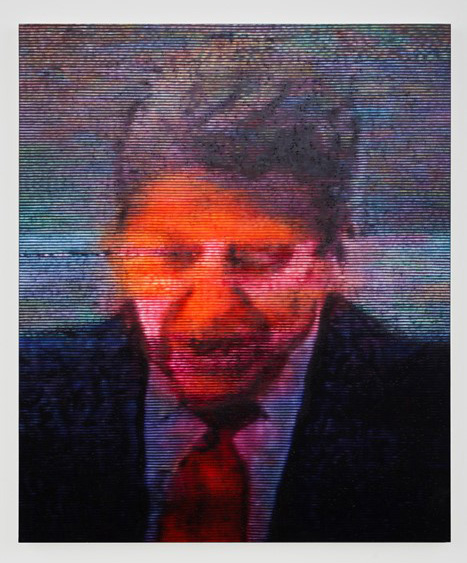
- Source: ARTNEWS
- Author: Liz Logan
- Date: January 14, 2015
- Format: PRINT AND DIGITAL
Lost in Translation:
Kon Trubkovich at OHWOW

A Trubkovich “Ronnie” Painting, Frozen Conflict, 2014
Courtesy the artist and OHWOW.
Adaptations of the folk standard “House of the Rising Sun” abound, but Moscow-born artist Kon Trubkovich was particularly fascinated by a video he recently found online of a group of Russians singing the song with their own made-up lyrics. He drew upon that discovery to create a multi-channel video installation, named after the song, that he refers to as “a dreamscape.” It will be on view this month as part of Trubkovich’s second solo show at OHWOW gallery in Los Angeles.
“The video is about a dislocation of meaning and things being obscured,” he said. “The song takes on a different meaning in another culture.”
Trubkovich, 35, spent his early years behind the Iron Curtain, and his family immigrated to the United States when he was eleven. This personal history is a rich source for his work, which deals with memory, identity, rebellion, and imprisonment. “I have a feeling of being nowhere, of impermanence, of non-identity,” he said. “My work is about remembering and forgetting.”
He is self-taught, and started exhibiting in 2005, making a name for himself with videos and large-scale oil paintings based on grainy film footage. The L.A. show will also include several “Ronnie” paintings, a continuation of Trubkovich’s series of works based on footage of Ronald Reagan’s “Tear Down This Wall” speech at the Brandenburg Gate, near the Berlin Wall, in 1987. (“The wall cannot withstand freedom,” Reagan said, his words broadcasted throughout North America and Western Europe.)
To create his paintings, Trubkovich starts with footage from VHS tapes. He dubs and re-dubs the tape, so the material starts to degrade. When he sees an image he likes, he takes a photograph of the screen, transfers the picture to canvas, and begins the multi-layered oil-painting process. Trubkovich spends roughly a month making each painting, with the help of three assistants. Recently he developed a similar process for his videos that includes transferring Internet footage onto 35-millimeter film, cutting and rearranging the frames, distorting the film, and painting on it.
In both the “Ronnie” paintings and House of the Rising Sun, cultural icons lose their original meanings when they’re repeated and changed. “The act of disappearance is something I relate to,” Trubkovich said. “I want someone to walk into this show and understand what it means to be upended.”

